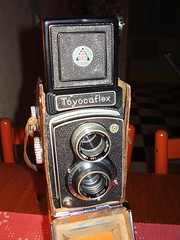Difference between revisions of "Toyocaflex"
m (→General links) |
Rebollo fr (talk | contribs) m (link fix) |
||
| Line 2: | Line 2: | ||
|image=[http://www.flickr.com/photos/ridicuul/430197846/in/pool-camerapedia/ http://farm1.static.flickr.com/175/430197846_03ce0de967_m.jpg] | |image=[http://www.flickr.com/photos/ridicuul/430197846/in/pool-camerapedia/ http://farm1.static.flickr.com/175/430197846_03ce0de967_m.jpg] | ||
}} | }} | ||
| − | The '''Toyocaflex'''<REF> "Toyoca" is certainly the contraction of <u>Toyo</u>hashi — Tougodo's hometown — and <u>Ca</u>mera. </REF> are Japanese 6×6 TLR cameras produced by [[Tougodo]] from early 1955. They are based on a [[Rolleicord]] and by consequence very similar to other Rolleicord-copy cameras, like the [[Yashica 6×6 TLR (crank advance)|Yashica-D]]. So similar in fact, that many Japanese TLR, such as the [[Starflex]]<REF> {{ | + | The '''Toyocaflex'''<REF> "Toyoca" is certainly the contraction of <u>Toyo</u>hashi — [[Tougodo]]'s hometown — and <u>Ca</u>mera. </REF> are Japanese 6×6 TLR cameras produced by [[Tougodo]] from early 1955. They are based on a [[Rolleicord]] and by consequence very similar to other Rolleicord-copy cameras, like the [[Yashica 6×6 TLR (crank advance)|Yashica-D]]. So similar in fact, that many Japanese TLR, such as the [[Starflex (postwar)|Starflex]]<REF> {{MK}}, p.902. </REF> or Skyflex<REF> http://photo.net/bboard/q-and-a-fetch-msg?msg_id=00IHsW </REF> are considered to be rebadged versions of the Toyocaflex. |
== Versions and operation == | == Versions and operation == | ||
Revision as of 10:54, 26 August 2010
The Toyocaflex[1] are Japanese 6×6 TLR cameras produced by Tougodo from early 1955. They are based on a Rolleicord and by consequence very similar to other Rolleicord-copy cameras, like the Yashica-D. So similar in fact, that many Japanese TLR, such as the Starflex[2] or Skyflex[3] are considered to be rebadged versions of the Toyocaflex.
Contents
Versions and operation
There seem to be at least two versions of this camera. The earlier one didn't have a bayonet mount. The later one accepts bay I filters and accessories (like sun shades). Both have Tri-Lausar 8cm/3,5 lenses for both the taking and viewing lens. Tri-Lausars are (would you have guessed?) three element lenses made by Tomioka. They do not enjoy a great reputation on the web[4]. There is a focusing knob on the right side of the camera. The distance scale is in feet only. This gives us a hint for which market it was intended. Opposite the distance scale is a depth-of-field table. On that same right side is an winding knob that also advances a mechanical frame counter. The shutter is cocked by a lever at a 10 o'clock position[5].
Speeds and aperture
Speeds and aperture are set by levers. Speeds range from B, 1-1/300s on an unmarked shutter. Apertures can be set from F/3,5 to 22.
Notes
- ↑ "Toyoca" is certainly the contraction of Toyohashi — Tougodo's hometown — and Camera.
- ↑ McKeown, p.902.
- ↑ http://photo.net/bboard/q-and-a-fetch-msg?msg_id=00IHsW
- ↑ 1. http://www.williamsphotographic.com/yashica.html, 2. http://medfmt.8k.com/mf/yashicaa.html. Most of the arguments given however, seem to come down to a similarity in sound (in English) between Tri-Lausar and lousy. Photographically not very convincing.
- ↑ On the later version. On the earlier version, the shutter is set by lever under the taking lens
Bibliography
- Asahi Camera (アサヒカメラ) editorial staff. Shōwa 10–40nen kōkoku ni miru kokusan kamera no rekishi (昭和10–40年広告にみる国産カメラの歴史, Japanese camera history as seen in advertisements, 1935–1965). Tokyo: Asahi Shinbunsha, 1994. ISBN 4-02-330312-7. Items 627–8 and 1389–91. (See also the advertisements for items 629–30
- Lewis, Gordon, ed. The History of the Japanese Camera. Rochester, N.Y.: George Eastman House, International Museum of Photography & Film, 1991. ISBN 0-935398-17-1 (paper), 0-935398-16-3 (hard). P.88 (brief mention only, spelled "Toyokaflex I" by mistake).
- McKeown, James M. and Joan C. McKeown's Price Guide to Antique and Classic Cameras, 12th Edition, 2005-2006. USA, Centennial Photo Service, 2004. ISBN 0-931838-40-1 (hardcover). ISBN 0-931838-41-X (softcover). P.932.
- Sugiyama, Kōichi (杉山浩一); Naoi, Hiroaki (直井浩明); Bullock, John R. The Collector's Guide to Japanese Cameras. 国産カメラ図鑑 (Kokusan kamera zukan). Tokyo: Asahi Sonorama, 1985. ISBN 4-257-03187-5. Items 2269–72.
- Watakushi no ni-gan-refu kamera-ten (私の二眼レフカメラ展, Exhibition of twin lens reflex cameras). Tokyo: JCII Camera Museum, 1992. (Exhibition catalogue, no ISBN number.) P. 31.
Links
General links
In English:
- Tougodo TLR cameras at Barry Toogood's tlr-cameras.com
- Skyflex at Westfordcomp
- Skyflex in flickr Camerapedia pool
In French:
- Toyocaflex in Lionel's 35mm-compact.com
- Toyocaflex in a comparison of various TLRs, at Pierre Dirapon's website
- Toyocaflex on www.collection-appareils.fr by Sylvain Halgand
In Japanese:
- Toyocaflex IB at Doraku Oyaji no Kamera Koheya
- Toyocaflex II at Otowa no nigan-refu
- Toyocaflex IIB and Toyocaflex TL-I at Japan Family Camera
- Toyocaflex IIB at Aya's Camera
- Toyocaflex in a post at Kan's Memo
In Chinese:
Repair notes
- Skyflex/Toyocaflex shutter repair in a post at photo.net
